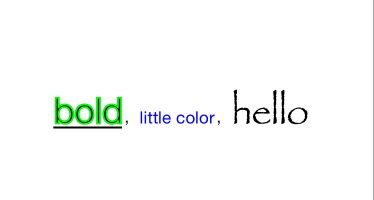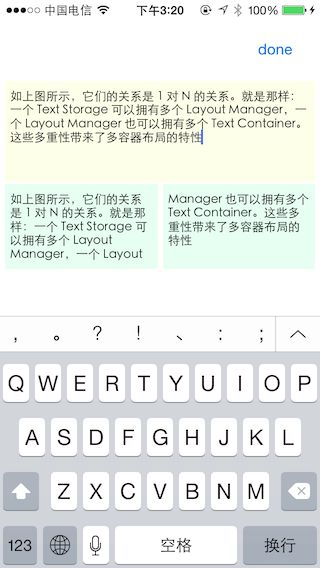TextKit
关注:http://www.jianshu.com/p/12a10e36d659
以前,如果我们想实现如上图所示复杂的文本排版:显示不同样式的文本、图片和文字混排,你可能就需要借助于UIWebView或者深入研究一下Core Text。在iOS6中,UILabel、UITextField、UITextView增加了一个NSAttributedString属性,可以稍微解决一些排版问题,但是支持的力度还不够。现在Text Kit完全改变了这种现状。
1.NSAttributedString
下面的例子,展示如何label中显示属性化字符串:
-(void)setAttributeStringLabel{
NSString *str = @"bold,little color,hello";
//NSMutableAttributedString的初始化
NSDictionary *attrs = @{NSFontAttributeName:[UIFont preferredFontForTextStyle:UIFontTextStyleBody]};
NSMutableAttributedString *attributedString = [[NSMutableAttributedString alloc]initWithString:str attributes:attrs];
//NSMutableAttributedString增加属性
[attributedString addAttribute:NSFontAttributeName value:[UIFont boldSystemFontOfSize:36] range:[str rangeOfString:@"bold"]];
[attributedString addAttribute:NSForegroundColorAttributeName value:[UIColor blueColor] range:[str rangeOfString:@"little color"]];
[attributedString addAttribute:NSFontAttributeName value:[UIFont fontWithName:@"Papyrus" size:36] range:NSMakeRange(18,5)];
[attributedString addAttribute:NSFontAttributeName value:[UIFont boldSystemFontOfSize:18] range:[str rangeOfString:@"little"]];
//NSMutableAttributedString移除属性
[attributedString removeAttribute:NSFontAttributeName range:[str rangeOfString:@"little"]];
//NSMutableAttributedString设置属性
NSDictionary *attrs2 = @{NSStrokeWidthAttributeName:@-5,
NSStrokeColorAttributeName:[UIColor greenColor],
NSFontAttributeName:[UIFont systemFontOfSize:36],
NSUnderlineStyleAttributeName:@(NSUnderlineStyleSingle)};
[attributedString setAttributes:attrs2 range:NSMakeRange(0, 4)];
self.label.attributedText = attributedString;
}运行结果如下:
需要注意的是,你不能直接修改已有的AttributedString, 你需要把它copy出来,修改后再进行设置:
NSMutableAttributedString *labelText = [myLabel.attributedText mutableCopy];
[labelText setAttributes:...];
myLabel.attributedText = labelText;2.Dynamic type:动态字体
iOS7增加了一项用户偏好设置:动态字体,用户可以通过显示与亮度-文字大小设置面板来修改设备上所有字体的尺寸。为了支持这个特性,意味着不要用systemFontWithSize:,而要用新的字体选择器preferredFontForTextStyle:。iOS提供了六种样式:标题,正文,副标题,脚注,标题1,标题2。例如:
_textView.font = [UIFont preferredFontForTextStyle:UIFontTextStyleBody];你可以接收用户改变字体大小的通知:
[[NSNotificationCenter defaultCenter] addObserver:self
selector:@selector(preferredContentSizeChanged:) name:UIContentSizeCategoryDidChangeNotification
object:nil];
-(void)preferredContentSizeChanged:(NSNotification *)notification{
_textView.font = [UIFont preferredFontForTextStyle:UIFontTextStyleBody];
}3.Exclusion paths:排除路径
iOS 上的 NSTextContainer 提供了exclusionPaths,它允许开发者设置一个 NSBezierPath 数组来指定不可填充文本的区域。如下图:
正如你所看到的,所有的文本都放置在蓝色椭圆外面。在 Text View 里面实现这个行为很简单,但是有个小麻烦:Bezier Path 的坐标必须使用容器的坐标系。以下是转换方法,将它的 bounds(self.circleView.bounds)转换到 Text View 的坐标系统:
- (void)updateExclusionPaths
{
CGRect ovalFrame = [self.textView convertRect:self.circleView.bounds fromView:self.circleView];
}因为没有 inset,文本会过于靠近视图边界,所以 UITextView 会在离边界还有几个点的距离的地方插入它的文本容器。因此,要得到以容器坐标表示的路径,必须从 origin 中减去这个插入点的坐标。
ovalFrame.origin.x -= self.textView.textContainerInset.left;
ovalFrame.origin.y -= self.textView.textContainerInset.top;在此之后,只需将 Bezier Path 设置给 Text Container 即可将对应的区域排除掉。其它的过程对你来说是透明的,TextKit 会自动处理。
self.textView.textContainer.exclusionPaths = @[[UIBezierPath bezierPathWithOvalInRect: ovalFrame]];4.多容器布局
NSTextStorage:它是NSMutableAttributedString的子类,里面存的是要管理的文本。
NSLayoutManager:管理文本布局方式
NSTextContainer:表示文本要填充的区域
如上图所示,它们的关系是 1 对 N 的关系。就是那样:一个 Text Storage 可以拥有多个 Layout Manager,一个 Layout Manager 也可以拥有多个 Text Container。这些多重性带来了多容器布局的特性:
1)将多个 Layout Manager 附加到同一个 Text Storage 上,可以产生相同文本的多种视觉表现,如果相应的 Text View 可编辑,那么在某个 Text View 上做的所有修改都会马上反映到所有 Text View 上。
NSTextStorage *sharedTextStorage = self.originalTextView.textStorage;
[sharedTextStorage replaceCharactersInRange:NSMakeRange(0, 0) withString:kstring];
// 将一个新的 Layout Manager 附加到上面的 Text Storage 上
NSLayoutManager *otherLayoutManager = [NSLayoutManager new];
[sharedTextStorage addLayoutManager: otherLayoutManager];
NSTextContainer *otherTextContainer = [NSTextContainer new];
[otherLayoutManager addTextContainer: otherTextContainer];
UITextView *otherTextView = [[UITextView alloc] initWithFrame:self.otherContainerView.bounds textContainer:otherTextContainer];
otherTextView.backgroundColor = self.otherContainerView.backgroundColor;
otherTextView.translatesAutoresizingMaskIntoConstraints = YES;
otherTextView.autoresizingMask = UIViewAutoresizingFlexibleWidth | UIViewAutoresizingFlexibleHeight;
otherTextView.scrollEnabled = NO;
[self.otherContainerView addSubview: otherTextView];
self.otherTextView = otherTextView;2)将多个 Text Container 附加到同一个 Layout Manager 上,这样可以将一个文本分布到多个视图展现出来。下面的例子将展示这两个特性:
// 将一个新的 Text Container 附加到同一个 Layout Manager,这样可以将一个文本分布到多个视图展现出来。
NSTextContainer *thirdTextContainer = [NSTextContainer new];
[otherLayoutManager addTextContainer: thirdTextContainer];
UITextView *thirdTextView = [[UITextView alloc] initWithFrame:self.thirdContainerView.bounds textContainer:thirdTextContainer];
thirdTextView.backgroundColor = self.thirdContainerView.backgroundColor;
thirdTextView.translatesAutoresizingMaskIntoConstraints = YES;
thirdTextView.autoresizingMask = UIViewAutoresizingFlexibleWidth | UIViewAutoresizingFlexibleHeight;
[self.thirdContainerView addSubview: thirdTextView];
self.thirdTextView = thirdTextView;结果如下所示:
5.语法高亮:继承NSTextStorage
看看 TextKit 组件的责任划分,就很清楚语法高亮应该由 Text Storage 实现。不过NSTextStorage 不是一个普通的类,它是一个类簇,你可以把它理解为一个"半具体"子类,因此要继承它必须实现以下方法:
- string;
- attributesAtIndex:effectiveRange:
- replaceCharactersInRange:withString:
- setAttributes:range:我们新建一个NSTextStorage的子类:SyntaxHighlightTextStorage
要实现以上4个方法,我们首先需要通过NSMutableAttributedString 实现一个后备存储,- setAttributes:range:这个方法需要用beginEditing和endEditing包起来,而且必须调用 edited:range:changeInLength:,所以大部分的NSTextStorage的子类都长下面这个样子:
@implementation SyntaxHighlightTextStorage
{
NSMutableAttributedString *_backingStore;
}
- (instancetype)init
{
self = [super init];
if (self) {
_backingStore = [NSMutableAttributedString new];
}
return self;
}
//1
- (NSString *)string {
return [_backingStore string];
}
//2
- (NSDictionary *)attributesAtIndex:(NSUInteger)location effectiveRange:(NSRangePointer)range
{
return [_backingStore attributesAtIndex:location
effectiveRange:range];
}
//3
- (void)replaceCharactersInRange:(NSRange)range withString:(NSString *)str
{
NSLog(@"replaceCharactersInRange:%@ withString:%@",NSStringFromRange(range), str);
[self beginEditing];
[_backingStore replaceCharactersInRange:range withString:str];
[self edited:NSTextStorageEditedCharacters | NSTextStorageEditedAttributes range:range changeInLength:str.length - range.length];
[self endEditing];
}
//4
- (void)setAttributes:(NSDictionary *)attrs range:(NSRange)range {
NSLog(@"setAttributes:%@ range:%@", attrs, NSStringFromRange(range));
[self beginEditing];
[_backingStore setAttributes:attrs range:range];
[self edited:NSTextStorageEditedAttributes range:range changeInLength:0];
[self endEditing];
}一个方便实现高亮的办法是覆盖 -processEditing,并设置一个正则表达式来查找单词,每次文本存储有修改时,这个方法都自动被调用。
- (void)processEditing
{
[super processEditing];
static NSRegularExpression *expression;
expression = expression ?: [NSRegularExpression regularExpressionWithPattern:@"(\\*\\w+(\\s\\w+)*\\*)\\s" options:0 error:NULL];
}首先清除之前所有的高亮:
NSRange paragaphRange = [self.string paragraphRangeForRange: self.editedRange];
[self removeAttribute:NSForegroundColorAttributeName range:paragaphRange];其次遍历所有的样式匹配项并高亮它们:
[expression enumerateMatchesInString:self.string options:0 range:paragaphRange usingBlock:^(NSTextCheckingResult *result, NSMatchingFlags flags, BOOL *stop) {
[self addAttribute:NSForegroundColorAttributeName value:[UIColor blueColor] range:result.range];
}];就这样,我们在文本系统栈里面有了一个 Text Storage 的全功能替换版本。在从 Interface 文件中载入时,可以像这样将它插入文本视图:
- (void)createTextView {
_textStorage = [SyntaxHighlightTextStorage new];
[_textStorage addLayoutManager: self.textView.layoutManager];
[_textStorage replaceCharactersInRange:NSMakeRange(0, 0) withString:@"在从 Interface 文件中载入时,可以像这样将它插入文本视图,然后加 *星号* 的字就会高亮出来了"];
_textView.delegate = self;
}运行如下:
6.文本容器修改:继承NSTextContainer
通过继承NSTextContainer,我们可以使得textView不再是一个规规矩矩的矩形。NSTextContainer负责回答这个问题:对于给定的矩形,哪个部分可以放文字,这个问题由下面这个方法来回答:
- (CGRect)lineFragmentRectForProposedRect: atIndex: writingDirection: remainingRect:所以我们在继承NSTextContainer的类中覆盖这个方法即可:
下面这个方法返回一个圆形区域:
- (CGRect)lineFragmentRectForProposedRect:(CGRect)proposedRect
atIndex:(NSUInteger)characterIndex
writingDirection:(NSWritingDirection)baseWritingDirection
remainingRect:(CGRect *)remainingRect {
CGRect rect = [super lineFragmentRectForProposedRect:proposedRect
atIndex:characterIndex
writingDirection:baseWritingDirection
remainingRect:remainingRect];
CGSize size = [self size];
CGFloat radius = fmin(size.width, size.height) / 2.0;
CGFloat ypos = fabs((proposedRect.origin.y + proposedRect.size.height / 2.0) - radius);
CGFloat width = (ypos < radius) ? 2.0 * sqrt(radius * radius - ypos * ypos) : 0.0;
CGRect circleRect = CGRectMake(radius - width / 2.0, proposedRect.origin.y, width, proposedRect.size.height);
return CGRectIntersection(rect, circleRect);
}使用这个继承类:
- (void)viewDidLoad {
[super viewDidLoad];
NSString *path = [[NSBundle mainBundle] pathForResource:@"sample.txt" ofType:nil];
NSString *string = [NSString stringWithContentsOfFile:path encoding:NSUTF8StringEncoding error:nil];
NSMutableParagraphStyle *style = [NSMutableParagraphStyle new];
[style setAlignment:NSTextAlignmentJustified];
NSTextStorage *text = [[NSTextStorage alloc] initWithString:string
attributes:@{
NSParagraphStyleAttributeName: style,
NSFontAttributeName: [UIFont preferredFontForTextStyle:UIFontTextStyleCaption2]
}];
NSLayoutManager *layoutManager = [NSLayoutManager new];
[text addLayoutManager:layoutManager];
CGRect textViewFrame = CGRectMake(20, 20, 280, 280);
CircleTextContainer *textContainer = [[CircleTextContainer alloc] initWithSize:textViewFrame.size];
[textContainer setExclusionPaths:@[ [UIBezierPath bezierPathWithOvalInRect:CGRectMake(80, 120, 50, 50)]]];
[layoutManager addTextContainer:textContainer];
UITextView *textView = [[UITextView alloc] initWithFrame:textViewFrame
textContainer:textContainer];
textView.allowsEditingTextAttributes = YES;
textView.scrollEnabled = NO;
textView.editable = NO;
[self.view addSubview:textView];
}效果如下:
7.布局修改:继承NSLayoutManager
利用NSLayoutManager的代理方法,我们可以轻松的设置行高:
- (CGFloat)layoutManager:(NSLayoutManager *)layoutManager
lineSpacingAfterGlyphAtIndex:(NSUInteger)glyphIndex
withProposedLineFragmentRect:(CGRect)rect
{
return floorf(glyphIndex / 100);
}假设你的文本中有链接,你不希望这些链接被断行分割。如果可能的话,一个 URL 应该始终显示为一个整体,一个单一的文本片段。没有什么比这更简单的了。
首先,就像前面讨论过的那样,我们使用自定义的 Text Storage,如下:
static NSDataDetector *linkDetector;
linkDetector = linkDetector ?: [[NSDataDetector alloc] initWithTypes:NSTextCheckingTypeLink error:NULL];
NSRange paragaphRange = [self.string paragraphRangeForRange: NSMakeRange(range.location, str.length)];
[self removeAttribute:NSLinkAttributeName range:paragaphRange];
[linkDetector enumerateMatchesInString:self.string
options:0
range:paragaphRange
usingBlock:^(NSTextCheckingResult *result, NSMatchingFlags flags, BOOL *stop)
{
[self addAttribute:NSLinkAttributeName value:result.URL range:result.range];
}];改变断行行为就只需要实现一个 Layout Manager 的代理方法:
- (BOOL)layoutManager:(NSLayoutManager *)layoutManager shouldBreakLineByWordBeforeCharacterAtIndex:(NSUInteger)charIndex
{
NSRange range;
NSURL *linkURL = [layoutManager.textStorage attribute:NSLinkAttributeName
atIndex:charIndex
effectiveRange:&range];
return !(linkURL && charIndex > range.location && charIndex <= NSMaxRange(range));结果就像下面这样:
你可以在这里下载到本文的代码。
参考:初识 TextKit,iOS 7 by Tutorials,iOS 7 Programming Pushing the Limits
原文链接:http://www.jianshu.com/p/2f72a5fa99f1
著作权归作者所有,转载请联系作者获得授权,并标注“简书作者”。






